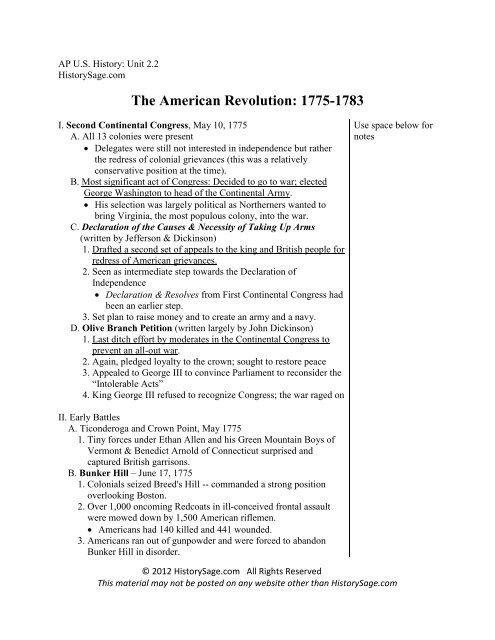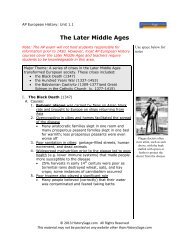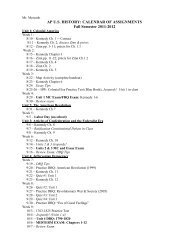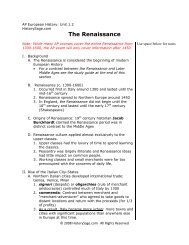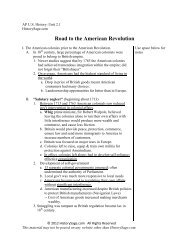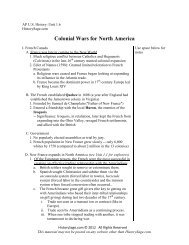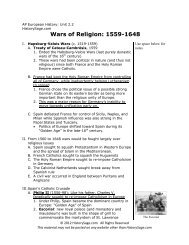The American Revolution: 1775-1783 - historysage.com
The American Revolution: 1775-1783 - historysage.com
The American Revolution: 1775-1783 - historysage.com
Create successful ePaper yourself
Turn your PDF publications into a flip-book with our unique Google optimized e-Paper software.
HistorySage.<strong>com</strong> APUSH Lecture Notes Page 4Unit 2.2 <strong>American</strong> <strong>Revolution</strong>5. Included the Anglican clergy and a large portion of theirfollowers; most numerous of the loyalists (except in Virginia)6. Influential in aristocratic NY, Charleston, PA, and NJ.7. Least numerous in New England8. Ineffective at gaining allegiance of neutral colonistsUse space below fornotesC. Patriots1. Sometimes called "whigs" (named after British opposition party)2. <strong>American</strong> rebels who fought both British soldiers and loyalists3. Most numerous in New England4. Constituted a minority movement5. More adept at gaining support from colonials6. Financing: Robert Morris, “the financier of the <strong>Revolution</strong>”helped Congress finance the war.D. About 80,000 Loyalists fled the colonies.1. Loyalists regarded by Patriots as traitors.2. <strong>The</strong>ir estates were confiscated and sold; these funds helpedfinance the war3. 50,000 fought for the BritishVI. <strong>The</strong> War in 1776-1777: Britain changed its focus to the mid-Atlantic statesA. Battle of Long Island (Summer & Fall 1776)1. Washington’s army escaped from Long Island to Manhattan andthen NJ.2. British lost a great opportunity to crush the <strong>American</strong>s early.B. Battle of Trenton (Dec. 1776)1. Washington crossed the icy Delaware River on Dec. 26, 17762. At Trenton, surprised and captured about 1,000 Hessians whowere sleeping off their Christmas party.C. Battle of Princeton (Jan. 1777)1. One week later, Washington defeated a smaller British force atPrinceton2. British forced to pull his outposts back to New York3. Trenton and Princeton was a gamble by Washington to achievequick victories to revive the disintegrating Continental Army.D. Battle of Saratoga (most important battle of the <strong>American</strong><strong>Revolution</strong>).1. British sought to capture New York and sever New England fromthe U.S.2. Benedict Arnold saved New England by slowing down the Britishinvasion of New York3. General Burgoyne surrendered his entire <strong>com</strong>mand at Saratoga onOct. 17, 1777 to <strong>American</strong> General Horatio Gates.4. Saratoga became one of history's most decisive battles© 2012 HistorySage.<strong>com</strong> All Rights Reserved
HistorySage.<strong>com</strong> APUSH Lecture Notes Page 5Unit 2.2 <strong>American</strong> <strong>Revolution</strong>a. Made possible French aid which ultimately ensured <strong>American</strong>independence.b. Spain & the Netherlands entered the war in 1779; Britain wasnow faced with world war.c. Saratoga revived the faltering colonial causeE. Washington retired to Valley Forge for winter of 1777-781. Supplies were scarce: food, clothing2. Army whipped into shape by the Prussian drillmaster Baron vonSteuben.3. Demonstrated <strong>American</strong> resolve despite horrible conditions.F. Benedict Arnold be<strong>com</strong>es a traitor, 1780 -- tremendous blow to<strong>American</strong> morale1. Arnold frustrated with his treatment by his superiors despite hisheroic service2. Persuaded Washington to make him head of West Point3. Plotted with the British to sell out the key stronghold of WestPoint <strong>com</strong>manding the Hudson River4. Plot failed after it was accidentally discovered by WashingtonUse space below fornotes:VII. Articles of Confederation adopted in 1777 (Drafted by JohnDickinson)A. Set up by the Second Continental Congress in order to create apermanent and constitutional government.B. Did not go into effect until 1781.C. First constitution in U.S. history; lasted until 1789 when theConstitution was adoptedD. Congress had power to: conduct war, handle foreign relations &secure loans, borrow money.E. No power to: regulate trade, conscript troops, levy taxes.VIII. <strong>The</strong> Franco-<strong>American</strong> AllianceA. French sought to exact revenge on Britain for the French &Indian War.1. Saw <strong>Revolution</strong>ary war as an opportunity.2. British America was England's most valuable colonies.B. Secret supply to the <strong>American</strong>s1. France initially worried that open aid to America might provokeBritish attacks on French interests..2. <strong>American</strong>s Silas Deane and Benjamin Franklin arranged forsignificant amounts of munitions and military supplies to beshipped to America. Helped forge the Franco-<strong>American</strong> Alliance.3. Marquis de Lafayette significant in helping U.S. get financialaid from France.C. Declaration of Independence was a turning point for French aid1. Showed <strong>American</strong>s meant business© 2012 HistorySage.<strong>com</strong> All Rights Reserved
HistorySage.<strong>com</strong> APUSH Lecture Notes Page 6Unit 2.2 <strong>American</strong> <strong>Revolution</strong>2. Victory at Saratoga showed U.S. had excellent chance fordefeating EnglandD. Franco-<strong>American</strong> Alliance, 1778: France offers U.S. a treaty ofalliance.1. Promised <strong>American</strong>s recognition of independence.2. Both sides bound themselves to wage war until the US won itsfreedom or until both agreed to terms with Britain.3. Many <strong>American</strong>s reluctantly accepted the treaty.a. France a strong Roman Catholic countryb. Hitherto a traditional enemy of Britain for centuries.Use space below fornotesE. <strong>The</strong> <strong>Revolution</strong> turned into a world war that stretched Britain’sresources.1. Spain and the Netherlands entered in 1779.2. Catherine the Great of Russia organized the League of ArmedNeutrality Lined up almost all remaining European neutrals in an attitudeof passive hostility toward England as a result of Britaindisturbing Baltic shipping.3. War raged in Europe, North America, South America, theCaribbean, and Asia.IX. Land Frontier & Sea FrontierA. West raged throughout most of the war1. Amerindian allies of Britain attacked <strong>American</strong> frontierpositions2. 1777 known as "the Bloody Year" on the frontier3. Thayendanegea, Joseph Brant (“Monster Brant”), a MohawkChief, and leader of the Iroquois Six Nations, led Amerindianraids in western Pennsylvania and New York. Forced to sign Treaty of Ft. Stanwyk -- first treaty betweenthe U.S. & Amerindians.o Iroquois lost most of their lands.B. Illinois country taken from the British1. George Rogers Clark, a frontiersman, seized several Britishports along the Ohio River: Kaskaskia, Cahokia (St. Louis), andVincennes, Indiana.2. Helped quiet Amerindian involvement3. His supporters credit him for forcing the British to cede the wholeOhio region in the peace treaty of Paris after the war. (This is stilla debate.)C. <strong>The</strong> <strong>American</strong> Navy1. John Paul Jones: most famous U.S. naval leader (Scottish born)2. Chief contribution was destroying British merchant shipping andcarrying war into the waters around the British Isles.3. Did not affect Britain's navy© 2012 HistorySage.<strong>com</strong> All Rights Reserved
HistorySage.<strong>com</strong> APUSH Lecture Notes Page 7Unit 2.2 <strong>American</strong> <strong>Revolution</strong>D. <strong>American</strong> Privateers were more effective than the <strong>American</strong> navy1. Privately owned ships authorized by Congress to attack enemyships.2. 600 British ships captured; British captured as many <strong>American</strong>merchantmen & privateers.3. Brought in gold, harassed the British, and increased <strong>American</strong>morale by providing <strong>American</strong> victories.E. Major naval battles between British, French, & other Europeanpowers1. Mostly in the West Indies2. British forces were over<strong>com</strong>e by French, Spanish and Dutchinvolvement <strong>The</strong> war ended in 1785 when Britain won last battle near India.Use space below fornotesX. In 1778, Britain again changed its strategy: focused on formerSouthern ColoniesA. Savannah, Georgia taken in late 1778-early 1779B. Charleston, SC, fell in 1780 (4th largest city in America)1. Devastating loss to <strong>American</strong> war-effort2. Heavier loss to the <strong>American</strong>s than Saratoga was to the BritishC. Nathanael Greene succeeded in clearing Georgia and S.C. of mostBritish troops-- Cornwallis forced to abandon the Southern strategy; fell back toChesapeake Bay at YorktownD. Battle of Yorktown, 1781: last major battle of the war1. French Admiral de Grasse, head of powerful fleet in Caribbean,blockaded Chesapeake Bay; British ships unable to enter.2. Washington made 300-mile+ march to Chesapeake Bay from NY.3. Ac<strong>com</strong>panied by Rochambeau's French army, Washingtonattacked British by land while de Grasse blockaded them by sea..4. Oct. 19, 1781, General Cornwallis surrendered entire force of7,000 men5. War continued one more year (especially in the South)XI. Peace at ParisA. Britain ready to <strong>com</strong>e to terms after losses in India, West Indies &the Mediterranean1. Lord North's ministry collapsed in 1782; George III lost influencein Parliament2. New Whig ministry (more sympathetic to <strong>American</strong>s) replacedthe Tory regime.© 2012 HistorySage.<strong>com</strong> All Rights Reserved
HistorySage.<strong>com</strong> APUSH Lecture Notes Page 8Unit 2.2 <strong>American</strong> <strong>Revolution</strong>B. France attempted to weaken the U.S.1. U.S. diplomats Ben Franklin, John Adams, and John Jay weresent by Congress to make no separate peace without consultingthe French.a. <strong>The</strong>y ignored these orders as they were highly suspicious ofFrance and Spain.b. John Jay believed France wanted to keep the U.S. border eastof the Allegheny mountains and give western territories to itsally, Spain, for its help in the war.2. U.S. surprisingly turned to Great Britaina. Britain was eager to separate U.S. from the Franco-<strong>American</strong>Alliance.b. A preliminary treaty was signed in 1782Use space below fornotesC. Treaty of Paris of <strong>1783</strong>: Britain formally recognized U.S.independence1. Granted the U.S. huge boundaries stretching to the MississippiRiver in the west, the Great Lakes in the north, and to SpanishFlorida in the southa. <strong>American</strong>s were allowed to retain a share in the valuableNewfoundland fisheries.b. British promised its troops would not take slaves from America.2. <strong>American</strong> concessions:a. Loyalists could not be further persecutedb. Congress was to re<strong>com</strong>mend to state legislatures thatconfiscated Loyalist property be restoredc. <strong>American</strong> states were bound to pay back Britishcreditors for pre-revolutionary debtsd. U.S. did not <strong>com</strong>ply with many of these concessions and itlater became a partial cause of the War of 1812 against Britain.3. France approved the British-<strong>American</strong> terms (officially, noseparate Franco-<strong>American</strong> peace occurred)4. America alone gained from the wara. Britain lost colonies and other territoriesb. France became bankrupt; led in part to the French <strong>Revolution</strong>.c. Spain gained littleXII. <strong>American</strong> society during the warA. Over 250,000 <strong>American</strong> soldiers fought-- 10% who fought died; largest % of any <strong>American</strong> war in historyB. British occupied most major cities, e.g. Boston, New York, andPhiladelphia.C. War Economy: all of society became involved in the war.1. State and national governments created.2. Men with military experience volunteered for positions in thearmy.© 2012 HistorySage.<strong>com</strong> All Rights Reserved
HistorySage.<strong>com</strong> APUSH Lecture Notes Page 9Unit 2.2 <strong>American</strong> <strong>Revolution</strong>3. Some merchants loaned money to the army and to Congress.Others made fortunes from wartime contracts.4. Most of the fighting was done by the poorest <strong>American</strong>s-- Young city laborers, farm boys, indentured servants, andsometimes slaves.5. African <strong>American</strong>s fought on both sides.-- 5,000 in the Continental army and nearly 30,000 in theBritish army in return for promises of freedom.6. Native Americas also fought with the British since they hoped tokeep land-hungry <strong>American</strong>s out of their territories.-- Bitter feelings remained long after the war ended.D. Women in the War1. Women managed farms and businesses while men served in thearmy2. Other women traveled with the Army as cooks and nurses.3. Women became more politically active and expressed theirthoughts more freely.4. A few even participated in the war itselfa. Deborah Sampson dressed up as a male and fought in thearmy until she was woundedb. Mary Ludwig Hays took over loading her husband’s canonafter he collapsedUse space below fornotesXIII. Why did the U.S. prevail in the <strong>Revolution</strong>ary War?A. Diplomatic:1. Declaration of Independence opened the door to the U.S.gaining foreign aid2. U.S. gained an alliance with France after the Battle ofSaratoga (1777); Spain and the Netherlands joined the waragainst Britain in 17793. U.S. gained loans from France, the Netherlands and others topay the costs of war (Benjamin Franklin and Silas Deanehelped secure loans)4. Distrust among Britain and France in Paris (<strong>1783</strong>) enabled theU.S. to play one off against the other and gain lands westwardto the Mississippi RiverB. Political:1. <strong>The</strong> British government proved to be inept; King George IIIand Lord North demonstrated poor leadership.Many Whigs in Britain cheered <strong>American</strong> victories; feareda Tory dictatorship in Britain2. <strong>American</strong> leaders were more successful at gaining support ofneutral colonists than were the Loyalists3. <strong>The</strong> Second Continental Congress ultimately declared<strong>American</strong> independence from Britain and gained support ofover 1/3 of <strong>American</strong> colonists© 2012 HistorySage.<strong>com</strong> All Rights Reserved
HistorySage.<strong>com</strong> APUSH Lecture Notes Page 10Unit 2.2 <strong>American</strong> <strong>Revolution</strong>4. Each of the thirteen colonies created sovereign republics thatappealed to <strong>American</strong> colonials5. Women played a vital role at home in support of the war6. <strong>American</strong> financier Robert Morris played a major role infinancing the war effortC. Military:1. <strong>The</strong> United States was too large a territory to conquer ANDoccupy. When the British captured large <strong>American</strong> cities, ithad little effect as most of America was rural.2. <strong>The</strong> British failed to take New England in <strong>1775</strong> and wereforced to move southward to occupy the Mid-Atlantic states.Eventually, the British failed to maintain effective control inthe Mid-Atlantic states and moved to the Southern stateswhere they were eventually defeated.3. <strong>The</strong> British alliance with Native <strong>American</strong>s did not result indecisive military victories.4. General Washington won important victories at critical timesand kept the <strong>American</strong> cause alive (e.g. Trenton, Princeton)5. Britain had to fight against <strong>American</strong> and French forces, andlater, Spanish and Dutch forces in other parts of the world.Thus, Britain could not focus all of its resources in NorthAmerica6. Communication between British forces in North America andGreat Britain was ineffective due to the time lag of travelingthe Atlantic Ocean.7. <strong>The</strong> French navy’s blockade of Chesapeake Bay sealed thefate of the British at the Battle of Yorktown.Memory Aid for Events Leading up to the <strong>Revolution</strong>:Pretty Proclamation of 1763Silly Stamp Act, 1765Tammy Townshend Acts, 1767Baked Boston Massacre, 1770Tea Tea Act, 1773CookiesCommittees of CorrespondenceInside “Intolerable Acts,” 1774FreshlyFirst Continental CongressLayeredLexington and ConcordSpicySecond Continental CongressDoughDeclaration of Independence© 2012 HistorySage.<strong>com</strong> All Rights Reserved
HistorySage.<strong>com</strong> APUSH Lecture Notes Page 11Unit 2.2 <strong>American</strong> <strong>Revolution</strong>Terms to KnowSecond Continental CongressDeclaration of the Causes andNecessity of Taking up ArmsOlive Branch petitionBunker HillThomas Paine, CommonSenseRichard Henry LeeDeclaration of IndependenceLoyalistsPatriotsBattle of TrentonBattle of SaratogaValley ForgeBaron von SteubenArticles of ConfederationMarquis de LafayetteFranco-<strong>American</strong> AllianceJoseph BrantNathanael GreenBattle of YorktownTreaty of Paris, <strong>1783</strong>Essay Questions: (both 2.1 and 2.2)Note: This sub-unit is part of Unit 2 which is a very highprobability area for the AP exam. In the past 10 years, 6questions have <strong>com</strong>e wholly or in part from the materialin this unit. Below are some questions that will help youstudy the topics that have appeared on previous exams.1. Analyze how the <strong>American</strong> colonies developed a sense ofidentity and unity in the decades prior to the <strong>American</strong><strong>Revolution</strong>.2. Analyze the political and economic causes for the <strong>American</strong>colonies’ resistance to British imperial rule between 1763and <strong>1775</strong>.3. Analyze the ideology behind the <strong>American</strong> colonies’resistance to British imperial.4. Analyze why the <strong>American</strong> colonies were able to win the<strong>American</strong> <strong>Revolution</strong>.5. To what extent were <strong>American</strong>s unified in the cause forindependence during the <strong>Revolution</strong>ary War?© 2012 HistorySage.<strong>com</strong> All Rights Reserved
HistorySage.<strong>com</strong> APUSH Lecture Notes Page 12Unit 2.2 <strong>American</strong> <strong>Revolution</strong>Bibliography:Bailyn, Bernard, <strong>The</strong> Ideological Origins of the <strong>American</strong> <strong>Revolution</strong>,Cambridge, Massachusetts: Belknep, 1967Berkin, Carol, et al., Making America: A History of the United States,Boston: Houghton Mifflin, 1999College Board, Advanced Placement Course Description: History --United States, College Entrance Examination Board, publishedannuallyCook, Don, <strong>The</strong> Long Fuse: How England Lost the <strong>American</strong> Colonies,1760-1785, New York: Atlantic Monthly Press 1995Cunningham, Jr., Noble E., In Pursuit of Reason: <strong>The</strong> Life of ThomasJefferson, New York: Balantine Books, 1987Foner, Eric & Garraty, John A. editors: <strong>The</strong> Reader’s Companion to<strong>American</strong> History, Boston: Houghton Mifflin Company, 1991Hofstadter, Richard, <strong>The</strong> <strong>American</strong> Political Tradition, New York:Alfred Knopf, 1948Kennedy, David M., Cohen, Lizabeth, Bailey, Thomas A., <strong>The</strong> <strong>American</strong>Pageant (AP Edition), 13 th edition, Boston: Houghton Mifflin 2006Morgan, Edmund S., <strong>The</strong> Birth of <strong>The</strong> Republic: 1763-89, 3rd edition,Chicago: University of Chicago, 1992Murrin, John et al., Liberty, Equality and Power, 2 nd ed., Fort Worth:Harcourt Brace 1999Nash, Gary, <strong>American</strong> Odyssey, Lake Forest, Illinois: Glencoe, 1992Wills, Garry, Inventing America: Jefferson's Declaration ofIndependence, New York: Vintage, 1978Wood, Gordon, Radicalism of the <strong>American</strong> <strong>Revolution</strong>, New York:Vintage Books, 1991Yanak, Ted, and Cornelison, Pam, <strong>The</strong> Great <strong>American</strong> History Fact-Finder, Boston: Houghton Mifflin, 1993Zinn, Howard, A People’s History of the United States, New York:Harper and Row, 1980© 2012 HistorySage.<strong>com</strong> All Rights Reserved


